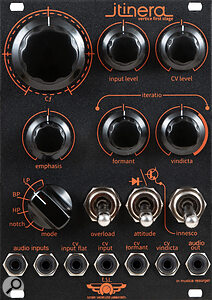The Itinera module is a Eurorack filter developed by Stefano Bersanetti at Euterpe Synthesizer Laboratories. The name Itinera comes from Latin, meaning ‘to come back multiple times’, which should give you a clue to the Itinera’s lineage. Itinera shares significant circuitry with its predecessor, the Vertice filterbank, which I reviewed in our April 2020 issue. The Vertice is a monster 5U rackmount triple filter made from vintage through‑hole electronic components, and the Itinera takes a single filter from the Vertice, adds a few new tricks, and packages it into an 18HP Eurorack module.
The Itinera isn’t like other filters. Yes, it has all the recognisable hallmarks: a nominal 12dB/oct response, low‑pass, band‑bass, high‑pass and notch modes, resonance (or Emphasis), and plenty of CV control. But beyond that, the Itinera shows many signs of mad professor design. For example, the notch mode often boosts rather than cuts, depending on the Emphasis setting. You can choose between two Emphasis types: the original Steiner resonance path, which is classic initially but becomes unstable at high values, or the Transistor mode, a design by Stefano that distorts and reduces the dynamic range, making the filter more stable but distorted.
There are also a bunch of switches and knobs mysteriously named in Latin. In the Transistor mode, the Innesco switch allows the filter to behave like a ‘Filtering Oscillator’, with a consistent low end that responds well to V/oct input. The filter also incorporates Iteratio functions, Formant and Vindicta, both highly dependent on Emphasis. The Formant Iteratio is designed to deform and fatten the signal by feeding the input signal back into the filter. In contrast, Vindicta (Latin for vengeance!) can inject more unexplained chaos and distortion into the circuity, even causing the sound to abruptly collapse and revive again, creating percussive patterns. Both are CV‑controllable, with dedicated knobs acting as attenuators for positive CV input.
If all this sounds confusing, don’t worry. The foreword of the included manual strongly discourages reading the document, suggesting it’s outdated, risky, and could lead to a conscious use of the device and undesirable knowledge. It includes hashtags like #donotreadmanuals and #neveragain. Of course, I did read it. My favourite part is the warning about the correct orientation for the power supply connection: red stripe down, which is emphasised in a dozen languages, including Latin and Klingon.
An Overdrive switch provides 40dB of distortion using silicon transistors, useful for distorting loud signals or boosting low‑level sources. It’s placed after the Input Level control and works with it. Boosting a very loud signal causes a loss of low frequency and dynamics. It enables the use of sources like passive electric guitars and piezoelectric microphones without a DI box. Various sounds, from clean to fuzzy, tube‑like to flat‑out transistor distortion, can be achieved by balancing Input Level and Overdrive.
There are plenty of inputs and outputs. Two inputs are summed together and sent to the filter. There are two frequency CV inputs (direct and attenuated) and CV controls for the Formant and Vindicta controls (the knobs become attenuators when a cable is plugged). And finally, a single audio output.
The filter market in Eurorack‑land is saturated (pun intended), but the Itinera stands out as unique.
The filter market in Eurorack‑land is saturated (pun intended), but the Itinera stands out as unique. If you like analogue attitude, it has bucket‑loads. It won’t be the first filter you reach for when you want a simple Moog‑like ladder sound or a gentle high‑pass to tame some rambunctious low end. Not that it cannot do these things, but rather that it will take some time to find those spots amongst a massive range of complex analogue circuit behaviour. That’s where this filter shines, in the madness and the experimental. In the sounds that make you wonder why or how. It can scream and howl more than any other filter in my collection. But it also can do luscious SSM‑like squelch (the band‑pass at medium resonance is an instant favourite). It can sound warm and gentle. It can do self‑oscillating feedback loops that make you wonder if an entire modular synth is hiding behind that beautiful 1970s panel design.
Itinera is more than a filter. It’s an attitude. The fact that the filter starts to self‑resonate when the Emphasis knob is at around 25 percent should give you a good indication of the type of filter you are dealing with. If Spinal Tap’s guitar amps reach 11, this thing reaches about 45.

